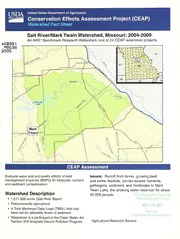
Salt river/Mark Twain watershed, Missouri : 2004-2009 : an ARS benchmark research watershed, one of 24 CEAP watershed projects : CEAP assessment. PDF
Preview Salt river/Mark Twain watershed, Missouri : 2004-2009 : an ARS benchmark research watershed, one of 24 CEAP watershed projects : CEAP assessment.
Historic, Archive Document Do not assume content reflects current scientific knowledge, policies, or practices. USDA United States Department of Agriculture Conservation Effects Assessment Project (CEAP) Watershed Fact Sheet Salt River/Mark Twain Watershed, Missouri: 2004-2009 An ARS* Benchmark Research Watershed, one of 24 CEAP watershed projects. a6B991 Evaluate water and soil quality effects of best Issues: Runoff from farms, growing beef management practices (BMPs) for herbicide, nutrient, and swine feedlots, carries excess nutrients, and sediment contamination. pathogens, sediment, and herbicides to Mark Twain Lake, the drinking water reservoir for about Watershed Description 40,000 people. • 1,611,500 acres (Salt River Basin) • Predominantly agricultural • A Total Maximum Daily Load (TMDL) limit has been set for allowable levels of sediment. • Watershed is a participant in the Clean Water Act Section 319 Nonpoint Source Pollution Program. *Agricultural Research Service 1023074861 Typical aerial photograph of the Mark Twain Lake watershed, showing View of runoff coming through a flume to measure flow rate, and an riparian corridors, grassed waterways, and the within-field spatial autosampler to collect water for analyses of nutrients and herbicides. variation that is common to the area. Runoff from 80-acre field watershed after storm during the 1993 flood View of Mark Twain Lake from Clarence Canon Dam. year. The weir allows calculation of flow rate from height measurements, and samplers nearby collect samples for nutrient and herbicide analyses. Approach Collaborators Water Sampling: Pesticides, phosphorus, nitrate- • USDA Natural Resources Conservation Service nitrogen, sediment, and pathogens from livestock • Food and Agricultural Policy Research Institute manure • Environmental Resources Coalition • Missouri Corn Growers Association Watershed Models: SWAT (Soil and Water Assessment Tool) Contacts Bob Ball, State CEAP Coordinator Research: Effectiveness, economics of various BMPs and weed management methods. ([email protected]) John Sadler, USDA ARS contact Communicating Results ([email protected]) Three annual progress reports planned. Also, new or Robert Lerch, Watershed Leader re-designed BMPs, decision support system based (LerchR @ Missouri.edu/) on SWAT data, recommendations by crop for entire NRCS State Conservationist Salt River basin, and journal articles. Roger Hansen The U.S. Department of Agriculture is an equal opportunity provider and employer. ju|y 2005 http://www.nrcs.usda.gov/technical/nri/ceap/
